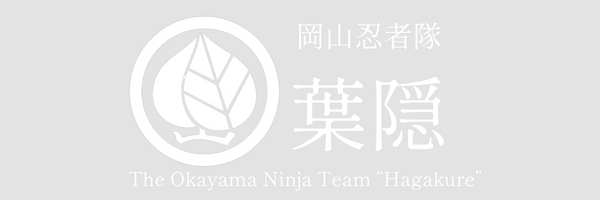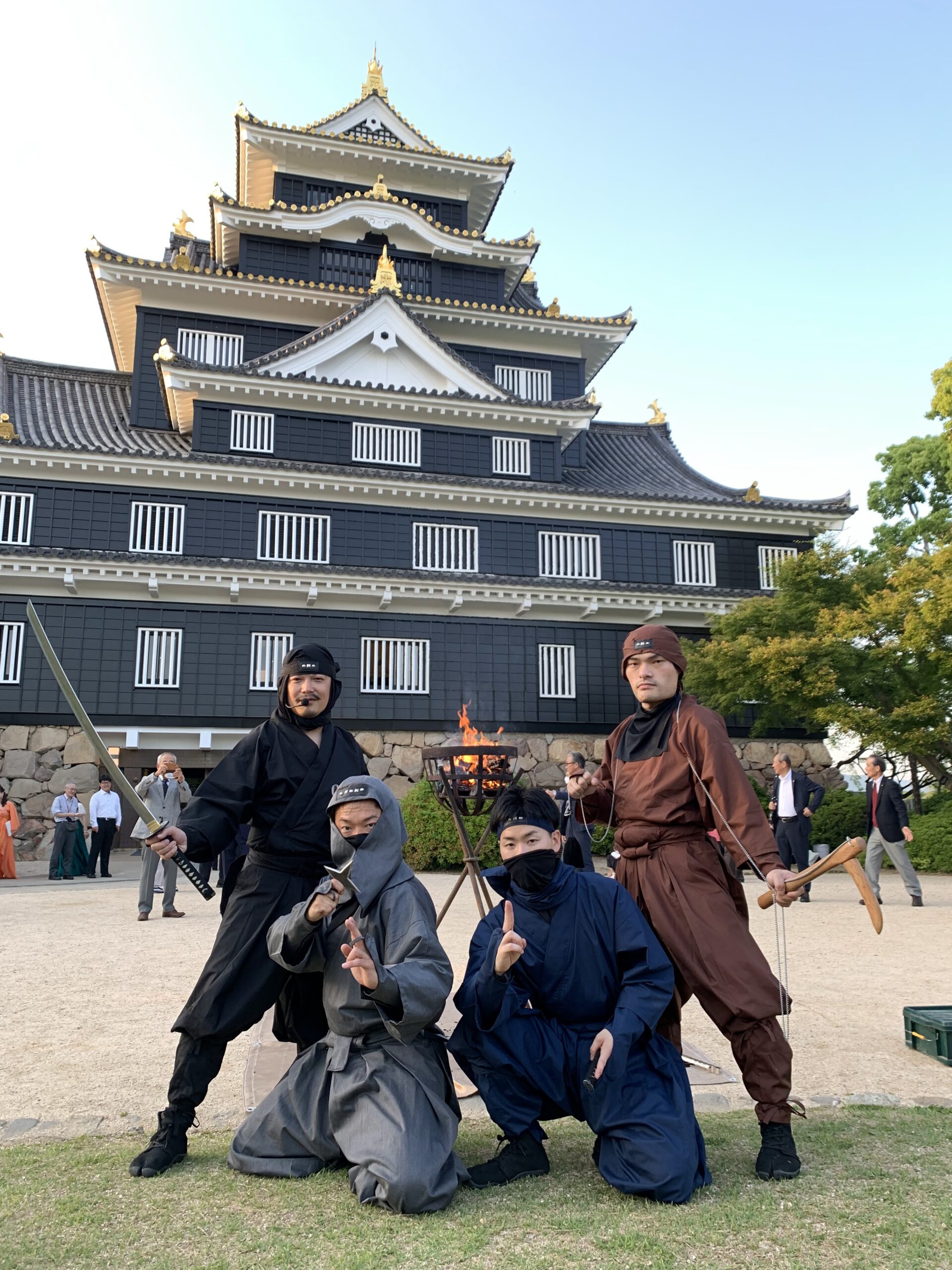「“どこの忍者?”と聞かれたら… 実は“岡山にも忍者がいた”」
「忍者と申せば、伊賀・甲賀が定番でしょ」
そう語る者は多かれど――
それだけでは、忍びの真実は見えてこん。
わしら岡山忍者隊「葉隠(はがくれ)」がここに存在するのも、ただの夢物語ではござらぬ。
なぜなら、この岡山の地にも、確かに“忍び”の足跡があったこと、文献にも伝承にも、しかと記されておるのじゃ。
時は戦国、備前・美作の国にもまた、幾多の武将が割拠し、
陰に日向に“影の者”たちが暗躍しておった。
なかでも異彩を放ったのが、宇喜多直家(うきたなおいえ)。
戦国の三梟雄のひとりとして知られる直家公は、
この岡山の地に城下町を築いた名将にして、謀略の達人――
合戦に及ぶ前に敵の心を読み、弱みを握り、間者を操って城を落とす、まさに“インテリジェンス戦”の申し子であった。
その策の裏には、名もなき忍びたちの働きがあったこと――
想像に難くはあるまい。
そしてその子、宇喜多秀家(ひでいえ)が築いたのが、岡山城――別名「烏城(うじょう)」である。
この城の構造にもまた、忍びの知恵が散りばめられておる。
侵入経路を読ませぬ複雑な堀と石垣。
身を潜め、密かに動くに適した狭間(さま)や見張り場。
さらには、城下に「抜け道」や「地下道」があったという口伝も残っておる。
これらは単なる防衛設備ではない。
情報を操り、人の動線を制御する“仕掛け”に他ならぬ。
そして何より、秀家公には二十名の忍者が仕えていたとの記録も伝わっておる。
つまりこの烏城こそ、忍びの活躍する舞台であったことは疑いようもない。
いま岡山城では、天守地下の展示スペースにおいて、
この地に実在した忍者に関する資料や紹介が行われておる。
かつて歴史の影に生きた者たちの姿を、現代に垣間見ることができる貴重な場――
興味ある者は、ぜひ一度、足を運んでみるがよい。
「忍者なんて、フィクションでしょ?」
そう笑う者もおろう。
だが、忍びの本質とは「目立たぬこと」「記録に残らぬこと」。
――証拠が少ないほど、そこには“本物の影”が潜んでいるものよ。
令和の世。
わしら岡山忍者隊「葉隠」は、その影の精神を継ぎ、
この地に眠る“忍びの知恵”を、いまに伝えんと立ち上がった。
演武もする。調査もする。子どもと遊び、SNSも操る――
まさに、現代忍者は「#忍ばない忍者」なのでござる!
岡山には、静かなる戦(いくさ)の歴史がある。
名を残さぬ者たちが、確かに生き、動いておった“影の記録”がある。
伊賀や甲賀だけが忍びにあらず。
この岡山の地にも、確かに「忍者はいた」――
それこそが、わしらの信念にして、誇りでござる。
【以下英語版】【English version below】
“Where are ninjas from?” — You might be surprised to know: There were ninjas in Okayama, too.
“When you hear the word ‘ninja,’ you probably think of Iga or Kōga, right?”
Indeed, many would say so.
But that alone does not reveal the full truth of the shinobi.
The existence of our group — the Okayama Ninja Corps “Hagakure” — is no mere fantasy.
For there is solid evidence, both in documents and local tradition, that true shinobi once walked the land of Okayama.
Back in the Warring States period (Sengoku era), the provinces of Bizen and Mimasaka were home to many feudal lords.
And moving within the shadows, aiding from behind the scenes, were the shinobi.
Among those lords, one stood out in particular — Ukita Naoie.
Naoie, known as one of the “Three Cunning Heroes of the Sengoku Era,” was a master strategist who laid the foundations for the castle town of Okayama.
Before battle even began, he would gather intelligence, uncover his enemy’s weaknesses, manipulate messengers, and seize castles without lifting a sword —
he was, in modern terms, a true master of information warfare.
And behind those brilliant maneuvers were shadow operatives… nameless ninjas working in silence.
His son, Ukita Hideie, built what would become the famed Okayama Castle, also known as “U-jō” (Crow Castle).
Its design, too, bears the marks of ninja wisdom.
Complex moats and stone walls made invasion paths unclear.
Narrow gaps and hidden watchpoints allowed for stealth and surveillance.
Legends speak of secret escape routes and underground tunnels beneath the castle town.
These were not just defensive features — they were infrastructures of control, used to manipulate information and human movement.
What’s more, historical records indicate that twenty ninjas were in service to Lord Hideie.
This “Crow Castle” was without a doubt a theater for shinobi activity.
Even today, visitors to Okayama Castle can explore a special exhibit in the underground floor of the keep,
featuring real records and displays about the historical ninjas who once operated in this region.
It is a rare chance to glimpse the true face of those who lived in the shadows of history.
If such things stir your curiosity — then you should come and see it for yourself.
“Ninjas? Aren’t they just fantasy?”
Many may scoff.
But the true essence of a shinobi lies in “being unseen” and “leaving no trace.”
The fewer the records, the more likely you’re glimpsing a real shadow.
Now, in the Reiwa era,
we of the Okayama Ninja Corps “Hagakure” carry on that spirit of shadow.
Our mission is to share the forgotten wisdom of the ninja — reawakening it in the present day.
We perform, we research, we teach children, we navigate the world of social media—
in short, we are the modern-day ninjas who do not hide.
Okayama has a history of quiet battles.
Records of nameless figures, moving silently through time, are woven into this land.
The ninja are not only from Iga and Kōga.
There were indeed ninjas in Okayama.
And that —
is our truth, and our pride.



